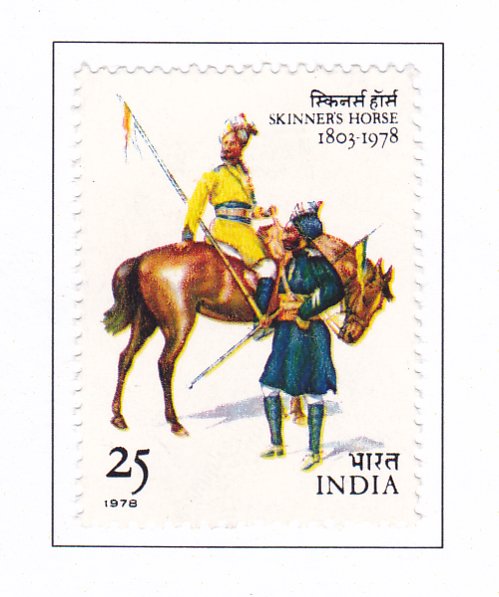175th Anniversary of Skinner’s Horse (Cavalry Regiment)

Technical Data
| Date of Issue | November 25, 1978 |
|---|---|
| Denomination | 25 p |
| Quantity | 3,000,000 |
| Perforation | comb 13 |
| Printer | Security Printing Press, Nashik |
| Watermark | No Watermark |
| Colors | Multicolor |
| Catalog Codes |
Michel IN 776 Stamp Number IN 812 Yvert et Tellier IN 572 Stanley Gibbons IN 902 |
| Themes | Animals (Fauna) | Anniversaries and Jubilees | Equestrianism and horse riding | Horses | Mammals | Military Forces |
The name may sound foreign, but it belongs to an illustrious Indian family that has been rooted in Uttar Pradesh, Delhi, and Haryana for nearly two centuries. James Skinner, the patriarch of this family and the founder of the esteemed cavalry regiment bearing his name, was born to a Scottish father and a Muslim Rajput mother. Being of mixed heritage, young Skinner faced restrictions from joining either the British or Indian wings of the East India Company’s army. Consequently, he offered his services to the Marathas and in 1795, enlisted in the Regular Army of Maharaja Daulat Rao Scindia.
Over the next eight years, Skinner honed his skills as a soldier, earning commendation in numerous battles and eventually gaining command of three battalions at the age of 22. When conflict arose between the British and the Marathas for control of Delhi and the Doab in 1803, Skinner was dismissed from Scindia’s service and reluctantly sought British protection. However, he agreed to raise and lead a force of horsemen from among his former comrades, on the condition that they would not be deployed against the Scindias.
For the first 136 years of its existence, Skinner’s Horse earned renown for its speed, boldness, mastery of various weapons, and a self-assurance encapsulated in their Persian motto “Himmat-I-Mardan, Madad-e-Khuda” (God helps those who help themselves). Evolving from horseback to armored cars and light tanks, they maintained their reputation as swift, fierce, and fearless warriors.
From 1803 to the present day, Skinner’s Horse has distinguished itself in campaigns across Asia, India, Afghanistan, and China, as well as in the battlefields of the First and Second World Wars. Post-Independence, the Regiment continued to excel, serving in various roles, including as a Recce Regiment in the Armored Division during the Hyderabad Police Action of 1948 and in combat operations during the Indo-Pak war in 1965.
In 1966, the Regiment transitioned to new medium tanks and became part of an armored brigade. During operations following Pakistani aggression against India’s western frontiers, the Regiment displayed exceptional prowess, destroying 14 Pakistani tanks while suffering only two losses of their own.
Throughout their history, Skinner’s Horse has maintained the traditional dress of the region, taking pride in their appearance and turnout. While their uniforms have evolved over time, their commitment to excellence remains unwavering. The Regiment’s expertise extends beyond warfare to sports, particularly those involving weapons and horses, such as marksmanship, polo, trick riding, and tent-pegging—a sport introduced into the Indian Army by Skinner himself.
The Post & Telegraph Department is delighted to commemorate the 175th anniversary of Skinner’s Horse by issuing a commemorative stamp.
